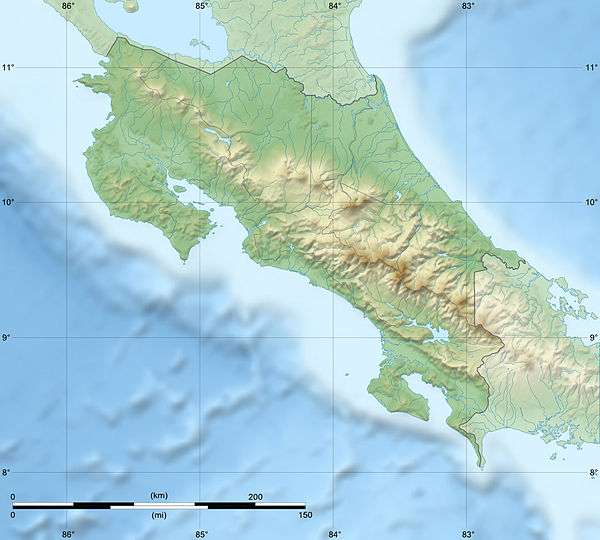Curré Formation
The Curré Formation is a geologic formation of the Taraba Basin Group in Costa Rica. The deltaic conglomerates preserve fossils dating back to the Late Miocene to Early Pliocene period (Hemphillian).[1]
| Curré Formation Stratigraphic range: Hemphillian ~10.3–4.9 Ma | |
|---|---|
| Type | Formation |
| Unit of | Taraba Basin Group |
| Underlies | El Brujo & La Cruz Formations |
| Overlies | Térraba Formation |
| Lithology | |
| Primary | Conglomerate |
| Location | |
| Coordinates | 8.9°N 83.1°W |
| Approximate paleocoordinates | 8.8°N 83.1°W |
| Region | Limón & Puntarenas Provinces |
| Country | |
| Extent | Taraba Basin |
| Type section | |
| Named for | Rey Curré |
 Curré Formation (Costa Rica) | |
Fossil content
The following fossils have been found in the formation:
- Aetobatus arcuatus
- Calippus hondurensis
- Carcharhinus longimanus, C. priscus
- Dasyatis cavernosa
- Dinohippus mexicanus
- Gavialosuchus americana
- Hemipristis serra
- Isogomphodon acuarius, I. caunellensis
- Isurus desorii
- Pleiolama vera
- Pliometanastes cf. protistus
- Protohippus gidleyi
- Rhynchotherium blicki
- Scirrotherium antelucanus
- Sibotherium ka[2]
- Sphyrna arambourgi
- Apalone sp.
- Arius sp.
- Eurhinodelphis sp.
- Goniodelphis sp.
- Hadrodelphis sp.
- Myliobatis sp.
- Orycterocetus sp.
- Rhinoptera sp.
- Sparus sp.
- Emydinae indet.
- Megatheriidae indet.
- Mylodontidae indet.
- Tayassuidae indet.
gollark: Project OBLIGATING ATLASES, presumably.
gollark: I am a GREAT staff.
gollark: Don't you sleep sometimes?
gollark: ↑
gollark: It happens in only 2024, surprisingly.
See also
- List of fossiliferous stratigraphic units in Costa Rica
References
- Curré Formation at Fossilworks.org
- Rincón et al., 2020
Bibliography
- Rincón, Ascanio D.; Ana L. Valerio, and César Laurito. 2020. Primer registro fósil de un Megatheriidae-Megatheriinae para el Hemphilliano (Mioceno Tardío) de San Gerardo de Limoncito, Formación Curré, Costa Rica. Revista Geológica de América Central 62. 1–24. doi:10.15517/rgac.v62i0.41278
Further reading
- C. Laurito, A. L. Valerio, E. Ovares, A. Hernández, and D. Pizarro. 2008. Peces Fósiles de la localidad Las Lomas de Siquirres cause del Río Reventazón, Formación Río Banano, Mioceno Superior, Provincia de Limón, Costa Rica [Fossil fishes of the Las Lomas de Siquirres Locality, Reventazon river, Rio Banano Formation, Late Miocene, Limon province, Costa Rica]. Revista Geológica de América Central 38:11-25
- C. A. Laurito and A. L. Valerio. 2008. The first record of Gavialosuchus americanus Sellards (1915)† (Eusuchia: Crocodylidae, Tomistominae) for the Late Tertiary of Costa Rica and Central America. Revista Geológica de América Central 39:107-115
This article is issued from Wikipedia. The text is licensed under Creative Commons - Attribution - Sharealike. Additional terms may apply for the media files.